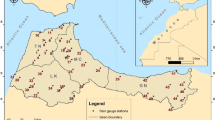Abstract
AMSR-E and MODIS are two EOS (Earth Observing System) instruments on board the Aqua satellite. A regression analysis between the brightness of all AMSR-E bands and the MODIS land surface temperature product indicated that the 89 GHz vertical polarization is the best single band to retrieve land surface temperature. According to simulation analysis with AIEM, the difference of different frequencies can eliminate the influence of water in soil and atmosphere, and also the surface roughness partly. The analysis results indicate that the radiation mechanism of surface covered snow is different from others. In order to retrieve land surface temperature more accurately, the land surface should be at least classified into three types: water covered surface, snow covered surface, and non-water and non-snow covered land surface. In order to improve the practicality and accuracy of the algorithm, we built different equations for different ranges of temperature. The average land surface temperature error is about 2–3°C relative to the MODIS LST product.
Similar content being viewed by others
References
Prata A J. Land surface temperatures from derived from the advanced very high resolution radiometer and the along-track scanning radiometer 2. Experimental results and validation of AVHRR algorithms. J Geopys Res, 1994, 99:13025–13058
Becker F, Li Z L. Towards a local split window method over land surface. Int J Remote Sens, 1990, 11: 369–393
Coll C, Caselles V, Sobrino A, et al. On the atmospheric dependence of the split-window equation for land surface temperature. Int J Remote Sens, 1994, 27: 105–122
FranÇa G B, Cracknell A P. Retrieval of land and sea surface temperature using NOAA-11 AVHRR data in northeastern Brazil. Int J Remote Sens, 1994, 15: 1695–1712
Harris A R, Mason I M. An extension to the split-window technique giving improved atmospheric correction and total water vapour. Int J Remote Sens, 1992, 13: 881–892
Sobrino J A, Coll C, Caselles V. Atmospheric corrections for land surface temperature using AVHRR channel 4 and 5. Remote Sens Environ, 1991, 38: 19–34
Price J C. Land surface temperature measurements from the splitwindow channels of the NOAA-7 AVHRR. J Geophys Res, 1984, 79: 5039–5044
Kerr Y H, Lagouarde J P. Imbernon J. Accurate land surface temperature retrieval from AVHRR data with use of an improved split window algorithm. Remote Sens Environ, 1992, 41: 197–209
Sobrino J A, Li Z L, Stoll M P, et al. Improvements in the split window technique for land surface temperature determination. IEEE Trans Geosci Remote Sens, 1994, 32: 243–253
Wan Z, Dozier J. A generalized split-window algorithm for retrieving land surface temperature measurement from space. IEEE Trans Geosci Remote Sens, 1996, 34: 892–905
Qin Z H, Giorgio D O, Arnon K. Derivation of split window algorithm and its sensitivity analysis for retrieving land surface temperature from NOAA-advanced very high resolution radiometer data. Geophys Res, 2001, 105: 22655–22670
Li Z, Becker F. Feasibility of land surface temperature and emissivity determination from AVHRR data. Remote Sens Environ, 1993, 43: 67–85
Wan Z M, Li Z L. A physics-based algorithm for retrieving land-surface emissivity and temperature from EOS/MODIS data. IEEE Trans Geosci Remote Sens, 1997, 35: 980–996
Gillespie A R, Rokugawa S, Matsunaga. A temperature and emissivity separation algorithm for advanced spaceborne thermal emission and reflection radiometer (ASTER) images. IEEE Trans Geosci Remote Sens, 1998, 36: 1113–1126
Mao K, Qin Z, Shi J, et al. A practical split window algorithm for retrieving land surface temperature from MODIS data. Int J Remote Sens, 2005, 8: 3181–3204
Mcfarland M J, Miller R L, Christopher M. Land surface temperature derived from the SSM/I passive microwave brightness temperature. IEEE Trans Geosci Remote Sens, 1990, 28: 839–845
Wan Z M, Zhang Y L, Zhang Q C, et al. Validation of the land-surface temperature products retrieved from terra moderate resolution imaging spectroradiometer data. Remote Sens Environ, 2002, 83: 163–180
Wan Z, Zhang Y, Zhang Q, et al. Quality assessment and validation of the MODIS global land surface temperature. Int J Remote Sens, 2004, 25: 261–274
Owe M, Richard D J, Walker J. A methodology for surface soil moisutre and vegetation optical depth retrieval using the microwave polarization difference index. IEEE Trans Geosci Remote Sens, 2001, 39: 1643–1654
Fung A K, Li Z, Chen K S. Backscattering from a randomly rough dieletric surface. IEEE Trans Geosci Remote Sens, 1992, 30: 356–369
Fung A K. Microwave Scattering and Emission Models and Their Applications, Artech House Inc. 1994. 227–303
Wu T D, Chen K S, Shi J, et al. A transition model for the reflection coefficient in surface scattering. IEEE Trans Geosci Remote Sens, 2001, 39: 2040–2050
Chen K S, Wu T D, Tsang L, et al. Emission of rough surfaces calculated by the integral equation method with comparison to three-dimensional moment method simulation. IEEE Trans Geosci Remote Sens, 2003, 41: 90–101
Author information
Authors and Affiliations
Corresponding author
Additional information
Supported by the National Natural Science Foundation of China (Grant Nos. 90302008 and 40571101), the Open Fund of Key Laboratory of Resources Remote Sensing and Digital Agriculture, MOA, and Project 863 (Grant No. 2006AA12Z103)
Rights and permissions
About this article
Cite this article
Mao, K., Shi, J., Li, Z. et al. A physics-based statistical algorithm for retrieving land surface temperature from AMSR-E passive microwave data. SCI CHINA SER D 50, 1115–1120 (2007). https://doi.org/10.1007/s11430-007-2053-x
Received:
Accepted:
Issue Date:
DOI: https://doi.org/10.1007/s11430-007-2053-x




